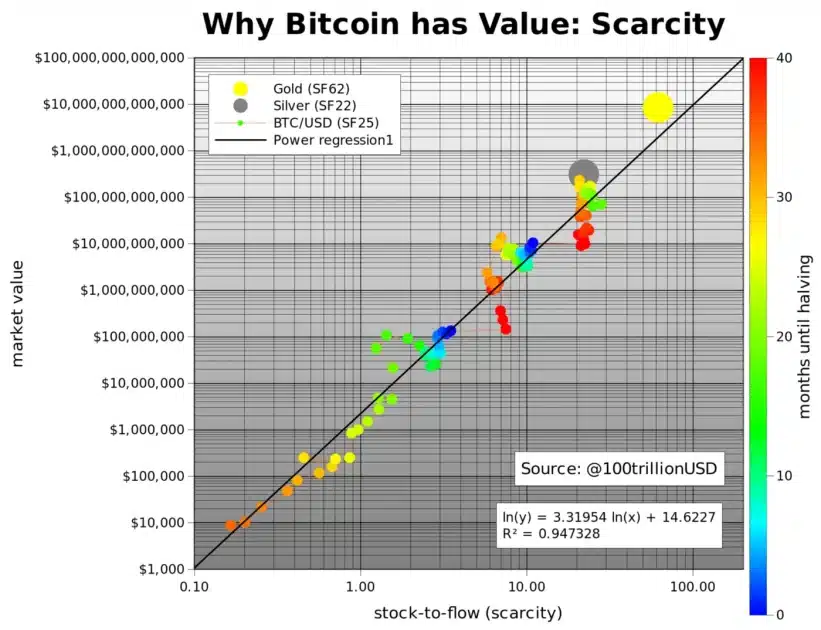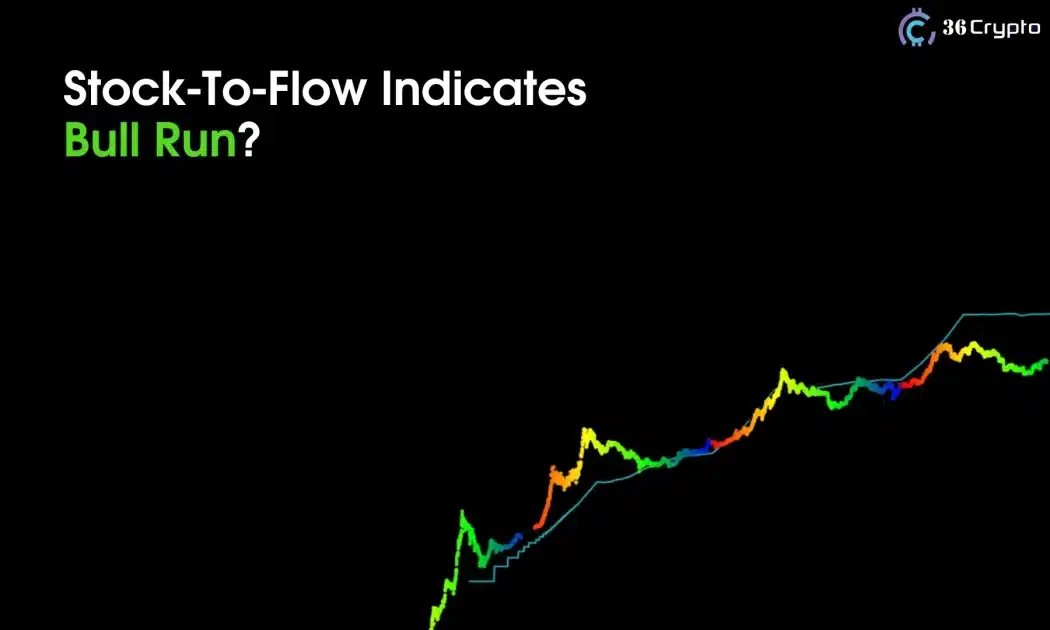PlanB utilizes his Stock-to-Flow strategy to come up with a bull run analysis. Discovering why this methodology is not the best option. Reputable analyst PlanB reported the beginning of the FOMO period – bull run market – based on the Stock-to-Flow research.
🔴RED DOT !!
Accumulation phase has ended: no more easy buying opportunities in orderly and slowly increasing markets.
Bull market has started. If history is any guide, we will see ~10 months of face melting fomo: extreme price pumps combined with multiple -30% drops. Enjoy!🚀 pic.twitter.com/8MyZJUSUlb
— PlanB (@100trillionUSD) March 1, 2024
“Accumulation phase has ended: no more easy buying opportunities in orderly and slowly increasing markets” – wrote PlanB in his post on X.
According to the investor, the market is expected to enter a 10-month FOMO, characterized by “extreme price pumps combined with multiple -30% drops”. Earlier PlanB claimed that Bitcoin will be scarcer than gold and real estate after halving. The presumption was based upon the Stock-to-Flow strategy as well.
What Is Stock-to-Flow
The Stock-to-Flow (S2F) strategy predicts the value of Bitcoin based on the stock-to-flow/production (SF) ratio. Its main idea is to prove that the price of a commodity will rise due to scarcity caused by an increase in the SF ratio.
The author of the Stock-to-Flow – an anonymous investor PlanB – created the model based on his calculations for precious metals such as silver and gold. Its first introduction took place in the article Modeling Bitcoin Value With Scarcity.
As for PlanB, the author claims to be an institutional investor with 25 years of experience, mainly spread out through finance and law. In one of his write-ups, the trader reports that he has managed multi-billion dollar assets. The identity of PlanB remains unknown up to this day.
How Stock-to-Flow Works
The model works upon Nick Szabo’s idea that the constant short supply of precious metals and collectibles comes due to the cost of production. This very approach was later adapted to Bitcoin by PlanB.
SF, a key metric of Stock-to-Flow, is calculated equal to the ratio of the asset’s stock to inflows – the inverse of supply growth. The stock equals the full amount of reserves, and the inflow equals the annual production or mining output.
Commodities indicating low SF – ferrous metals, consumables, etc. – are not rare. If their prices increase, producers will simply substantially increase production and eliminate scarcity. For rare objects with high SF, the same approach devours greater cost and resource capacity.
As of the reporting time, the SF of Bitcoin indicates 56.9 on the 10-day timeframe and 55.5 on the 463-day timeframe. The inflow is determined by the reward per block that is about to be decreased amidst the upcoming halving event.

Graphical representation of Stock-to-Flow model. Source: Modeling Bitcoin Value With Scarcity | PlanB Medium Blog
The graph uses a logarithmic scale that visualizes values from $10,000 to $100 billion. The time until the next halving is shown using a color gradient. Dark blue corresponds to the month in which the block award decreased and red corresponds to the month following the event.
Earlier, with the help of the model, PlanB predicted that Bitcoin’s market capitalization would be $1 trillion and its price would exceed $55,000 after the 2020 halving.
Stock-to-Flow Deflection Indicator
Consequently, the trading community came up with a Stock-to-Flow Deflection. This technical indicator stands for the ratio between the factual price of Bitcoin and its value, calculated with the SF model.
The indicator functions as follows: if Stock-to-Flow Deflection takes a value less than one, this signals that Bitcoin is undervalued. By contrast, if the parameter exceeds rate one, the value of the cryptocurrency is signaled to fall.
Some traders use this indicator to buy Bitcoin if its value is below the estimated one and open short positions when the cryptocurrency is overvalued.
Why Stock-to-Flow Is Criticised?
Since the model’s introduction, it could not get a global foothold in traders’ strategies.
Nico Cordeiro, the chief investment officer and fund manager at Strix Leviathan, believes that the “model’s accuracy will likely be about as successful at forecasting Bitcoin’s future price as the astrological models of the past were at predicting financial outcomes”.
He argues that the model’s correlation with the USD market capitalization of a monetary good (e.g. gold and silver) is proofless and goes against Bitcoin’s trajectory.
“This becomes quite obvious when one extends the model into the near future. By 2045, the model estimates each Bitcoin will be worth $235,000,000,000”, writes Nico Cordeiro for Coindesk.
Cordeiro also criticizes the naїve application of a linear regression that results in a high probability of a researcher finding “good” statistical results.
“It is common for researchers to underestimate how often such techniques lead to false results. And particularly in this situation, where there is a large degree of freedom for random data to fit a specific outcome.”
The analyst also notes the wrong use of “scarcity” as a notion and a metric within the model. Namely, PlanB uses “scarcity” to describe an asset’s supply growth rate or new production as measured by the SF metric. This assumes that increasing new supply depresses prices through increased selling pressure from producers and vice versa, which has nothing to do with reality.
The Stock-to-Flow model received criticism from Vitalik Buterin as well. The creator of the Ethereum network wrote that “financial models that give people a false sense of certainty” are “harmful and deserve all the mockery they get”.
The statement came in response to Sassal.eth’s feedback on Stock-to-Flow, citing it to be “hopium garbage” and “epic failure”.
From what we can say, Stock-to-Flow, just like any other model, does not take fundamental or contiguous factors into account. In the informational society, the market becomes dependent on it.
Namely, the adoption of Bitcoin ETF, or, presumably, a cross-chain collaboration between WhiteBIT and NEAR Protocol, which envisages increased HOT token mining activity and USDT/USDC usage, may cause a significant impact on crypto and hence reflected on the chart.
Stock-to-Flow Potential
Using the Stock-to-Flow model, PlanB managed to predict the growth of Bitcoin to $55,000. Moreover, the original mode has been advanced, while it still can’t be used for other assets other than cryptocurrency.
The author of Stock-to-Flow and its followers agree that the exponential increase in the price of Bitcoin will stop, and the model may be less relevant in the future. However, he still assumes Bitcoin’s value will rise due to undervaluation and scarcity.
Free Tool: Use our simple crypto profit calculator to calculate your potential profits and returns on your cryptocurrency investments.<<<
Read more:
- The Future of Cryptocurrency: What to Expect in 2024
- Weekly Crypto News: Telegram Pays Toncoins, WhiteBIT Is Now TradingView Broker and More
- Will the Binance Situation Affect the Tightening of Cryptocurrency Regulations?


